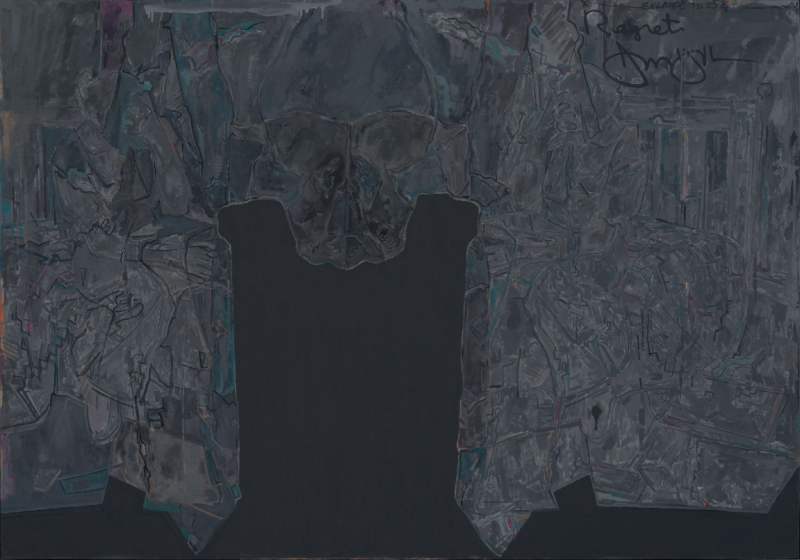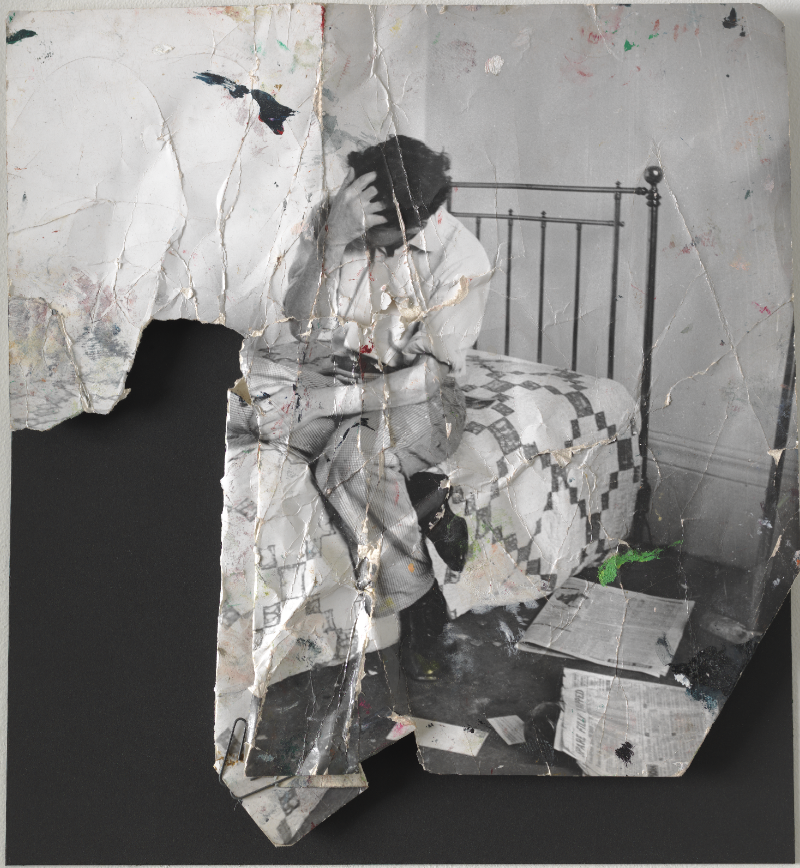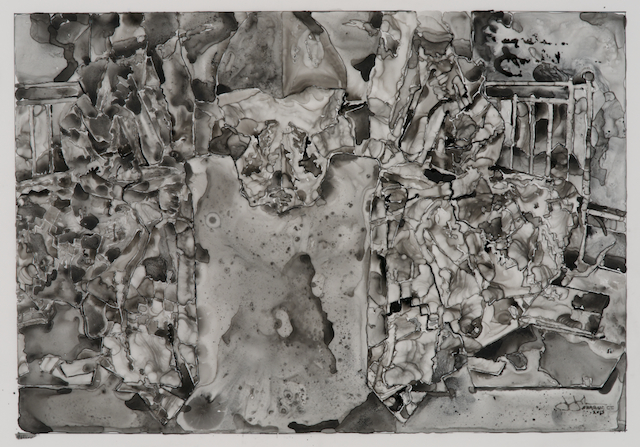Jasper Johns: Regrets, Courtauld Gallery | reviews, news & interviews
Jasper Johns: Regrets, Courtauld Gallery
Jasper Johns: Regrets, Courtauld Gallery
A rich and multifaceted body of work that offers a modern twist on the memento mori

In your ninth decade it may not come as a surprise to find death staring you in the face. But it might be unnerving if you’re an artist and a menacing “death's head” skull emerges, quite unexpectedly, in an image you’ve been staring at and working from with close scrutiny for weeks and months. You might even take it, if so inclined, as a sign – if only as a sign that chance works in mysterious ways.
Jasper Johns has said he didn’t begin with the intention of a creating a modern memento mori, but, serendipitously, this is how it's turned out. This cohesive series of drawings, prints and paintings, which he has called Regrets – a somewhat bathetic title for a series touching on mortality, but we’ll come back to that in a moment – was recently shown at the Museum of Modern Art, New York. In something of an unprecedented move, MoMA hastily cleared its schedules and arranged the exhibition before the work had even left Johns’ studio. Of the 14 works displayed, 10 have now arrived at the Courtauld Gallery – minus two etchings and two ink-on-plastic (Mylar) drawings, as well as the original photograph on which the work is based.
That black and white photo (pictured below) was taken in 1964 by John Deakin, the heavy-drinking Soho photographer who, memorably riffing on one of Francis Bacon’s pope paintings, took portraits of Bacon with two “angelic” carcass wings. Bacon, who disliked painting from the live model, asked Deakin to take some pictures of his friend Lucian Freud in a series of poses from which Bacon could work.
 And so, sitting on a brass bed covered with a patchwork quilt and with discarded newspapers at his feet, we find Freud hunched over and with one hand clasped to his head in a pose reminiscent of both Rodin’s The Thinker and the sleeping artist besieged by demonic owls and bats in Goya’s famous etching The Sleep of Reason Produces Monsters. Found in Bacon’s densely cluttered studio after his death in 1992, the photograph seems to have been put to energetic use; it is creased and distressed and splattered with paint. The left and bottom edges are torn off or folded back, with a paper clip holding the folded creases in place. Where parts of the photographic print are missing, we see a black backing, as if the image has been consumed by a void. In its tattered state, it's a magnificently powerful image.
And so, sitting on a brass bed covered with a patchwork quilt and with discarded newspapers at his feet, we find Freud hunched over and with one hand clasped to his head in a pose reminiscent of both Rodin’s The Thinker and the sleeping artist besieged by demonic owls and bats in Goya’s famous etching The Sleep of Reason Produces Monsters. Found in Bacon’s densely cluttered studio after his death in 1992, the photograph seems to have been put to energetic use; it is creased and distressed and splattered with paint. The left and bottom edges are torn off or folded back, with a paper clip holding the folded creases in place. Where parts of the photographic print are missing, we see a black backing, as if the image has been consumed by a void. In its tattered state, it's a magnificently powerful image.
Johns encountered the Deakin photo in 2012, in a Christie’s auction catalogue promoting the sale of the painting that resulted from it – not, it should be noted, a painting of Freud by Bacon, but of a study for a self-portrait by Bacon, with Bacon’s head and features on a similarly contorted body. Make of this odd physical merging what you will; Freud’s grandfather surely would have.
Drawn to the arresting image, Johns immediately set to work, producing first a sketch – jotting down three words, Goya? Bats? Dream?, on one – then a densely cross-hatched coloured-pencil drawing where the figure seems to take on the aspect of a jigsaw puzzle, or one of Johns’ coloured maps of America. Eventually he mirrors the image like a Rorschach blot, with Freud’s figure facing itself in a symmetrical composition. With each process and with each new medium – pencil, watercolour, ink-on-plastic, oil paint, photocopy – Johns manipulates the figure in new ways, emphasising this or hiding that aspect of the original image. Of the finished pieces, we find ones that obviously work better than others, but, as a body of work, seen as a process, the unfolding sequence is completely enthralling. There’s such a keen, searching wit and intelligence at work behind these manipulations.
The doubling of the image is where it gets significantly more interesting. This is where the creased and distressed portion of the wall on the right of the photograph forms, when mirrored, a hovering skull in the dead centre of the finished work. And this skull finds itself resting on a kind of funereal plinth or tombstone, which might also be seen as a gaping doorway (through which, once entered – if we want to be schlocky about it – we can never return). But what’s so frankly odd, as well as amusing, if not a little unnerving, is that in one of the paintings, the largest work in the display (main picture), where Johns has shifted the central image a little to the left, so that its symmetry is slightly off-kilter, the skull actually resembles – my eyes can’t possibly betray me here – the pinched and jowly outline of Johns’ own face. It simply looks like him.
 That painting, at first glance, looks to be completely modulated in greys, then slowly gives up its subtle palette of blues, pinks and oranges across its ragged patchwork surface. But the most seductive works in the series are the two ink-on-plastic drawings, their surfaces an intricate and layered web of ink stains, the blots and delicate marks conveying the tension between chance and control (see picture above). The two here are beautiful.
That painting, at first glance, looks to be completely modulated in greys, then slowly gives up its subtle palette of blues, pinks and oranges across its ragged patchwork surface. But the most seductive works in the series are the two ink-on-plastic drawings, their surfaces an intricate and layered web of ink stains, the blots and delicate marks conveying the tension between chance and control (see picture above). The two here are beautiful.
And of that slightly mawkish title given to the series? “Regrets” is how Johns signs off, with an efficient rubber stamp, all unwelcome invitations. Most of these works have been signed off in a similar way.
The final invitation is, of course, one’s appointment with death, which, regrettably, one can’t turn down. But, in the event, what richly allusive work to sign off with.
Explore topics
Share this article
The future of Arts Journalism
You can stop theartsdesk.com closing!
We urgently need financing to survive. Our fundraising drive has thus far raised £49,000 but we need to reach £100,000 or we will be forced to close. Please contribute here: https://gofund.me/c3f6033d
And if you can forward this information to anyone who might assist, we’d be grateful.

Subscribe to theartsdesk.com
Thank you for continuing to read our work on theartsdesk.com. For unlimited access to every article in its entirety, including our archive of more than 15,000 pieces, we're asking for £5 per month or £40 per year. We feel it's a very good deal, and hope you do too.
To take a subscription now simply click here.
And if you're looking for that extra gift for a friend or family member, why not treat them to a theartsdesk.com gift subscription?
more Visual arts
 'We are bowled over!' Thank you for your messages of love and support
Much-appreciated words of commendation from readers and the cultural community
'We are bowled over!' Thank you for your messages of love and support
Much-appreciated words of commendation from readers and the cultural community
 Photo Oxford 2025 review - photography all over the town
At last, a UK festival that takes photography seriously
Photo Oxford 2025 review - photography all over the town
At last, a UK festival that takes photography seriously
![SEX MONEY RACE RELIGION [2016] by Gilbert and George. Installation shot of Gilbert & George 21ST CENTURY PICTURES Hayward Gallery](https://theartsdesk.com/sites/default/files/styles/thumbnail/public/mastimages/Gilbert%20%26%20George_%2021ST%20CENTURY%20PICTURES.%20SEX%20MONEY%20RACE%20RELIGION%20%5B2016%5D.%20Photo_%20Mark%20Blower.%20Courtesy%20of%20the%20Gilbert%20%26%20George%20and%20the%20Hayward%20Gallery._0.jpg?itok=7tVsLyR-) Gilbert & George, 21st Century Pictures, Hayward Gallery review - brash, bright and not so beautiful
The couple's coloured photomontages shout louder than ever, causing sensory overload
Gilbert & George, 21st Century Pictures, Hayward Gallery review - brash, bright and not so beautiful
The couple's coloured photomontages shout louder than ever, causing sensory overload
 Lee Miller, Tate Britain review - an extraordinary career that remains an enigma
Fashion photographer, artist or war reporter; will the real Lee Miller please step forward?
Lee Miller, Tate Britain review - an extraordinary career that remains an enigma
Fashion photographer, artist or war reporter; will the real Lee Miller please step forward?
 Kerry James Marshall: The Histories, Royal Academy review - a triumphant celebration of blackness
Room after room of glorious paintings
Kerry James Marshall: The Histories, Royal Academy review - a triumphant celebration of blackness
Room after room of glorious paintings
 Folkestone Triennial 2025 - landscape, seascape, art lovers' escape
Locally rooted festival brings home many but not all global concerns
Folkestone Triennial 2025 - landscape, seascape, art lovers' escape
Locally rooted festival brings home many but not all global concerns
 Sir Brian Clarke (1953-2025) - a personal tribute
Remembering an artist with a gift for the transcendent
Sir Brian Clarke (1953-2025) - a personal tribute
Remembering an artist with a gift for the transcendent
 Emily Kam Kngwarray, Tate Modern review - glimpses of another world
Pictures that are an affirmation of belonging
Emily Kam Kngwarray, Tate Modern review - glimpses of another world
Pictures that are an affirmation of belonging
 Kiefer / Van Gogh, Royal Academy review - a pairing of opposites
Small scale intensity meets large scale melodrama
Kiefer / Van Gogh, Royal Academy review - a pairing of opposites
Small scale intensity meets large scale melodrama
 Jenny Saville: The Anatomy of Painting, National Portrait Gallery review - a protégé losing her way
A brilliant painter in search of a worthwhile subject
Jenny Saville: The Anatomy of Painting, National Portrait Gallery review - a protégé losing her way
A brilliant painter in search of a worthwhile subject
 Abstract Erotic, Courtauld Gallery review - sculpture that is sensuous, funny and subversive
Testing the boundaries of good taste, and winning
Abstract Erotic, Courtauld Gallery review - sculpture that is sensuous, funny and subversive
Testing the boundaries of good taste, and winning
 Edward Burra, Tate Britain review - watercolour made mainstream
Social satire with a nasty bite
Edward Burra, Tate Britain review - watercolour made mainstream
Social satire with a nasty bite

Add comment